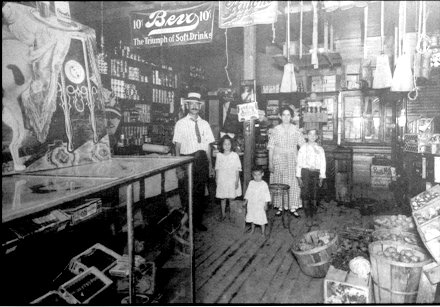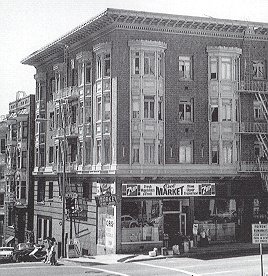The Corner Store
Today, let's buy candy at the corner store. The University of Houston's College of Engineering presents this series about the machines that make our civilization run, and the people whose ingenuity created them.
Our next-door neighbors during the depression years in St. Paul were a Russian-Jewish family. The parents got out before the Revolution, and in the wake of pogroms. They lived upstairs in a duplex and worked long hours running a nearby corner grocery while their children went to the university.
Now I find the museum catalog for Ellen Beasley's exhibit at the National Building Museum in Washington, DC. It's called The Corner Store, and it brings those sweet and difficult years of the 1930s back with great poignancy. Beasley has studied the corner stores of Galveston, Texas. And, while they have their own flavor, I still have no trouble tracing my childhood within them.
The corner store was a practical answer to real need, back when few people had automobiles, and primitive ice boxes were all we had to store food. It was normal to walk to the store and to buy in small quantities. Small stores were spread throughout the city. My bicycle gave me ready access to six or seven of them.
They were corner stores because that's where they were visible in residential neighborhoods. And, since they had to be staffed for long hours with the whole family pitching in, we often found them in the half-basement of an apartment building with the family living upstairs. We used our pennies to buy candy on the way home from grade school. Some of the family owners would tolerate us; others would let us know that we were pests.
Corner stores were above ground in low-lying Galveston, but the same people ran them. Beasley shows photos of the Cantini and Tropea families. Arminio Cantini emigrated to Galveston in 1910 and married first-generation Elena LaBarbera here. They ran stores in the neighborhood of K and 38th while they built up enough capital to go into other dealings. During those years they sold every kind of grocery. Then they pumped gas for early drivers, as well.
Sebastiano Tropea was a first-generation American. He joined the Merchant Marines and met his wife Angeline in Italy, after WW-II. They were latecomers to the corner store when they bought one at F and 16th in 1959. But they ran it until 1981.
They made their own sausage and together this strikingly handsome couple became more than corner store proprietors. They became keepers of an old institution in a city famous for honoring historic institutions. By 1981, the automobile, the shopping cart, the refrigerator, and the supermarket had long since ended the era of the corner store. By then, the educated children of those storekeepers next door to us were finishing their professional careers.
I pause as I pass tinned meats or bulk candy in the supermarket. For there I meet fleeting ghosts of the old corner store. I wouldn't be so foolish as to want to go back. But I surely treasure the memory of those old portals into the good life - into penny candy and into bare needs - into education and into prosperity.
I'm John Lienhard, at the University of Houston, where we're interested in the way inventive minds work.
(Theme music)
Beasley, E., The Corner Store. Washington, DC: National Building Museum, 1999.
I am grateful to Ellen Beasley for additional counsel.

A typical family operation: Sebastiano and Georgia Mencacci and their children inside their store at the corner of Avenue O-1/2 and 21st Street in Galveston. This picture was taken around 1910 and provided courtesy of Leo H. Mencacci, Jr.
(from the Beasley source above.)

Owl Market,1001 Bush Street, San Francisco. This surviving corner store is part of an apartment built in 1915.
(Photo, courtesy of Ann Bloomfield, from the Beasley source above.)